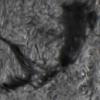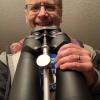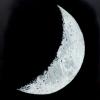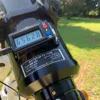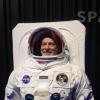
Roland's 10" Mak versus a 10" f/5 reflector
#26

Posted 27 April 2013 - 10:11 PM
I've been observing planets for decades. Even as a kid I was the patient observer. Its my natural thing to lose myself in the observation. Over the course of several months with the 10" f/5 (my prior scope being a C8 and prior to that an old orange C8) I really gave it my all. I was very dissatisfied with the performance - even sending it back to Parks saying that while their accompanied ronchi was ruler straight this was not a performer. I began to see traces if astig at the larger exit pupils of low power but that's a side note that obviously wasn't the issue of PARKS. Anyway, Clements is on the phone with me saying "Jupiter ought to look like gangbusters with this mirror" - they sent it back nothing changed. The night I had a local club menber invite me to come over and let him have a look it was all over. Jupiter was up and he had his 10" f/7 Cave and I realized that was what I wanted. I messed with the collimation doing the high power diffraction pattern centering - he messed with it too. I just had it. I sold the beast and was dead set on a scope from Parralax Instruments. Their brochures aeed to embody my wants here and a check was nearly in the mail till Chris at PARKS said " yes we do custom telescope assemblies". That's all it took. - check was in the mail and the weeks passed. When I finally got it the views were a revelation outdoing any instrument Ive ever owned - certainly the 10" f/5. But it wasn't just planetary Ed...
The Orion Nebula was up I swung it there for a gander and saw clearer than any view before the E-F stars in the trap and in mediocre seeing. Those months I had the ten they didn't budge even once. Jupiter now had these flashes of watermark intensity markings that I never noticed before. It was uncanny. Mind you it wasnt a matter of paying extra attention - these things came to me . I wasn't even thinking of the E-F stars and Jupiter was so good it took getting used to. Saturn later on proved equally stunning and I even went headlong into doubles that spring summer and fall - an interest that was always so-so to me. Clements suggested I try doubles with the scope, I was polite and silently scoffed at it. Bootes was riding that spring and it was a nearly year long obsession. I was seeing these text book star patterns the ten never seemed to manage. Instead he rings tended to blur into the disc - wether it was seeing or extra light in the diffraction rings it was a downer. Other 10" scopes at star parties of the f4.5 variety and such left me equally ho-hum. The one that wasnt was a home made 10" F/7 with a PARKS mirror and dang it what a fabulous Saturn!
The other scopes to sum it up were big bright blah images. That uncanny tickle of gossamer details that flutter with the seeing just kind of simplified into something that didn't move me. Eh.
Sometimes I regret having let the 10" go - I lost angular res and some deepsky ability. I wonder what I might have or could have done to make it work but Im happy enough with the carefree, coma free easy collimating f/9 and I leave it there.
Maybe the next time Im at a star party and there's another fast ten Ill give a look see . The images in the f/9 though again were a revelation. If it'd been even a little ho hum Id ve sold it - as it is this was no. 4 in a succession of buying, trying and selling. This one for me was the winner.
Pete
Ps: I've read through all the technicals on MTF. I'm going to rereading it all tomorrow morning when Im fresh. Again thanks.
#27

Posted 27 April 2013 - 10:27 PM
How ARE you saving those aberrator mtf images - I can't manage this but Id like to be able to save them for comparisons I do.
Thanks.
Pete
#28

Posted 27 April 2013 - 11:34 PM
Aberrator does not allow you to generate more than one MTF at a time.
I did not realize that you had tow different 10" scopes.
My guess was that the f/7 one was more optimized than the f/5 one, but if an f/5 scope were built with a 20% secondary and the optics were of superb quality, then it should do as well as the MCT.
But this would be a custom scope, and the off axis illumination would not be great. But still, you would likely have the same true field capability of the f/14.4 AP, with a bit of coma of course. At the center of the field, the performance should be similar.
#29

Posted 28 April 2013 - 06:52 AM
What's a fn/print screen?
I didn't have two ten inch scopes - one was a friends from a local club I spent the evening with another was at a starparty . Sorry for the confusion on description.
Pete
#30

Posted 28 April 2013 - 07:27 AM
On the planets I'd much rather use an f/15 Mak with a 10mm eyepiece than struggle with an f/5 Newtonian with any 3.5mm eyepiece you can name (to achieve roughly the same magnification).
Barlows/Powermates etc don't help either.
#31

Posted 28 April 2013 - 07:56 AM
The scopes:
10" f/14.6 Mak 23% co
10" f/5 newt 26% co
Ok, no doubt Roland's Mak is corrected to a higher degree than any 10" f/5, too a paracor would eat up the throughput advantage of the newt s simple design but that still makes it seem like the reflector has a fighting chance to match this $10,000 OTA Mak.
So what's going on here? Is Roland really getting 10" f/5 planetary performance? Or is the ability to perfect a maks optics so much better than a similar parabola that no reflector in that size can realistically hope to compete?
Pete
Why would a faster OTA be in the running as a comparable or better planetary instrument?
I have the AP 10" Mak-Cass and a good number of other fine scopes (AP apos, Zeiss APQs, Tak Mewlon 300CR), and have looked through a lot of other's telescopes. Roland's Mak-Cass provides about as close to refractor performance as I've seen. In addition to delivering highly detailed views of the planets (Jupiter & Saturn), it performs well on Lunar features, globular clusters and other DSOs. Thus far, it has given me the best view of M42 (with a Leitz 30 mm 88* AFOV EP). It easily shows the central star of M57, because it can tolerate ridiculously high magnification.
I may be selling a scope or two soon to purchase an FLI CCD camera. My AP Mak-Cass will never leave.
#32

Posted 28 April 2013 - 09:15 AM
This will make an image of your desktop in your computer clipboard.
Now, when you want to edit it, just open Microsoft Paint and do a "Paste." The image of your desktop will show up in Paint.
I did two different Aberrator images into two different Paint Windows, then cut and pasted the MTF from one to the other, then cropped everything else out.
It is only a little tedious, but I do it so that it is easy to make a side by side comparison for interested people that are interested.
Of course I realize that most people are not at all interested, but as you can see, MTF offers a very visual way of comparing how two different instruments might perform.
#33

Posted 28 April 2013 - 09:21 AM
And the reality is that it has to be in the running because not everyone can afford a $10,000 telescope.
And when you could put together a telescope offereing similar performacne with a tracking mount for less than $3000, most people would say that this would indeed be a valid challanger.
The only issue with building an f/5 planetary scope is that the small obstruction required would make it unusable for wider field viewing, but then again, a 10" f/14.4 MCT does not really offer much in the way of wide field viewing either.
Still, if you used a very low profile focuser on the Newtonian, you could potentially have a wider true field than the f/14.4 MCT.
So, similar planetary performance and a wider field of view for maybe 25% of the price.
Sure, one is an AP and one is an Orion Dob with custom mirrors, but if the goal is to see an equal amount of detail on planets, then you can get there with an optimized 10" f/5.
#34

Posted 28 April 2013 - 10:24 AM
Why would a faster OTA be in the running as a comparable or better planetary instrument?
A point I think is worth making: The primary mirror of the Mak is in the F/3 realm. Compound scopes are very fast spherical mirrors combined with corrective optics and a magnifying secondary mirror to achieve that slow focal ratio. While the optics may be spherical they are not in the scope in question and one can fabricate a somewhat slower parabola with equal precision.
Jon
#35

Posted 28 April 2013 - 10:25 AM
You're all missing something - you need eyepieces to see anything. It isn't just about CO and MTF.
On the planets I'd much rather use an f/15 Mak with a 10mm eyepiece than struggle with an f/5 Newtonian with any 3.5mm eyepiece you can name (to achieve roughly the same magnification).
Barlows/Powermates etc don't help either.
No they dont. Barlows are cosmetic attachments to make low power oculars feel mighty.
P.
#36

Posted 28 April 2013 - 10:29 AM
Function Key, Print Screen Key on your keyboard.
This will make an image of your desktop in your computer clipboard.
Now, when you want to edit it, just open Microsoft Paint and do a "Paste." The image of your desktop will show up in Paint.
I did two different Aberrator images into two different Paint Windows, then cut and pasted the MTF from one to the other, then cropped everything else out.
It is only a little tedious, but I do it so that it is easy to make a side by side comparison for interested people that are interested.
Of course I realize that most people are not at all interested, but as you can see, MTF offers a very visual way of comparing how two different instruments might perform.
Im thinking of an overlay here in photoshop where both are visible as one image. I could color shift one to separate it from the other .
Just a thought.
Pete
#37

Posted 28 April 2013 - 03:30 PM
When you have had a chance to do one, would you show me what it looks like
#38

Posted 28 April 2013 - 06:19 PM
You're all missing something - you need eyepieces to see anything. It isn't just about CO and MTF.
On the planets I'd much rather use an f/15 Mak with a 10mm eyepiece than struggle with an f/5 Newtonian with any 3.5mm eyepiece you can name (to achieve roughly the same magnification).
Barlows/Powermates etc don't help either.
No they dont. Barlows are cosmetic attachments to make low power oculars feel mighty.
P.
As someone who actually uses F/5 Newtonians for Planetary viewing, Barlows can be an effective tool. It's probably easier to fabricate a high quality Barlow than a high quality 5x magnifying mirror...
Jon
#39

Posted 28 April 2013 - 07:03 PM
The speed of an optical system does not really have much bearing on its ability to perform well on planets.
And the reality is that it has to be in the running because not everyone can afford a $10,000 telescope.
And when you could put together a telescope offereing similar performacne with a tracking mount for less than $3000, most people would say that this would indeed be a valid challanger.
The only issue with building an f/5 planetary scope is that the small obstruction required would make it unusable for wider field viewing, but then again, a 10" f/14.4 MCT does not really offer much in the way of wide field viewing either.
Still, if you used a very low profile focuser on the Newtonian, you could potentially have a wider true field than the f/14.4 MCT.
So, similar planetary performance and a wider field of view for maybe 25% of the price.
Sure, one is an AP and one is an Orion Dob with custom mirrors, but if the goal is to see an equal amount of detail on planets, then you can get there with an optimized 10" f/5.
I would expect with faster optics, more care needs to be applied with figuring them.
Also, I doubt that an Orion Newtonian can perform as well as the AP Mak-Cass.
#40

Posted 28 April 2013 - 08:14 PM
I started out in astronomy when I was 14 years old 1972!
ground my first telescope lense when I was 16-1974!
Worked for Celestron !978-1980 as optical Assembler Mainly
worked on C-14!
And have used and built many scopes in my life time!
#41

Posted 28 April 2013 - 08:59 PM
I have seen some fantastic views in newtonians in my life time!
I started out in astronomy when I was 14 years old 1972!
ground my first telescope lense when I was 16-1974!
Worked for Celestron !978-1980 as optical Assembler Mainly
worked on C-14!
And have used and built many scopes in my life time!
I'm not knocking the virtues of Newtonians with well-figured mirrors. I'm simply suggesting that an AP 10" f/14.6 Mak-Cass will outperform a more conventional 10" f/5 Newt on lunar and planetary views for several reasons.
#42

Posted 28 April 2013 - 09:28 PM
Planetary but mak are awesome scopes for it -
but expensive lol!
#43

Posted 29 April 2013 - 03:46 AM
What does concern me - after 40 years experience - is the performance of eyepieces, especially short ones. If you regularly observe at x1 or more per mm of aperture a long focal ratio scope coupled with a quite modest medium f.l. eyepiece is a far more appropriate solution than any f/5 scope no matter how perfect the primary, and any eyepiece combination your can come up with.
One of the major drawbacks at the eyepiece end - especially with very short f.l. eyepieces - is the scattering, losses and general image degradation arising from the number of air-glass surfaces and the scattering within the eyepiece. Adding a Barlow or PowerCorr only makes it worse.
#44

Posted 29 April 2013 - 06:13 AM
What does concern me - after 40 years experience - is the performance of eyepieces, especially short ones. If you regularly observe at x1 or more per mm of aperture a long focal ratio scope coupled with a quite modest medium f.l. eyepiece is a far more appropriate solution than any f/5 scope no matter how perfect the primary, and any eyepiece combination your can come up with.
I think Texereau said it best:
"It is not usually made clear, that these elements, objective and eyepiece, are by no means comparable in importance. The astronomer's hopes are almost wholly tied to the size and quality of the objectve. The objective of even the smallest telescope, because of its larger dimensions, the severe optical requirements it must meet, and the difficulty of its construction, completely overshadows the eyepiece."
- "How to Make a Telescope," by Jean Texereau, Page 1, Paragraph 2.
When it comes to planetary viewing, the most important factor is the seeing, then comes the scope, the size, the quality and thermal state.
Jon
#45

Posted 29 April 2013 - 06:09 PM
You're all missing something - you need eyepieces to see anything. It isn't just about CO and MTF.
On the planets I'd much rather use an f/15 Mak with a 10mm eyepiece than struggle with an f/5 Newtonian with any 3.5mm eyepiece you can name (to achieve roughly the same magnification).
Barlows/Powermates etc don't help either.
No they dont. Barlows are cosmetic attachments to make low power oculars feel mighty.
P.
As someone who actually uses F/5 Newtonians for Planetary viewing, Barlows can be an effective tool. It's probably easier to fabricate a high quality Barlow than a high quality 5x magnifying mirror...
Jon
I was jesting. I love barlows.
Pete
#46

Posted 30 April 2013 - 12:33 AM
... a direct practical test on Saturn which at the moment is near the zenith here - my 7" f/15 Mak vs a very good 10" f/5 dob 2 nights ago.
The 10" dob gave a brighter image, no question, but the 7" Mak showed more details on Saturn.
The eyepieces used in both scopes were my set of Vixen LVW's; 13mm in the 7" Mak gave almost identical magnification as 5mm in the 10" dob. The owner of the dob was quite interested in the side-by-side comparison.
A good 10" f/15 Mak will easily SLAY a 10" f/5 newtonian on the planets, for resolution of fine detail.
#47

Posted 30 April 2013 - 06:13 AM
Pete
#48

Posted 30 April 2013 - 07:42 PM
10" f/14.6 Mak 23% co
10" f/5 newt 26% co
For a 10 inch F5 Newt, 26 percent CO seems a little high. There are models that are in the 20-22 percent range. However, I don't think a few percent extra CO will be all that noticeable if the optics are of high quality.
#49

Posted 30 April 2013 - 08:42 PM
Pete
#50

Posted 18 May 2013 - 07:30 PM
There was a thread a while back that pitted a 250 Mewlon against the 10" AP and I picked the 10" AP on that one.
For that one, the Mewlon had a meaningfully bigger CO, but more importantly, the bench tests I have seen on Mewlons have led me to believe that they are not made to the same high level of perfection that you would get from either the AP or a custom mirror Dob.
Would appreciate if you can point us to these bench tests??
There are quite a few interested people including me that would find this helpful as comparison for future purchases.









